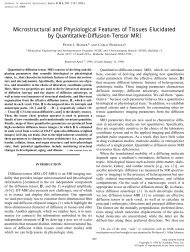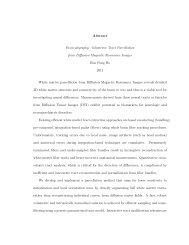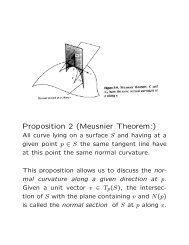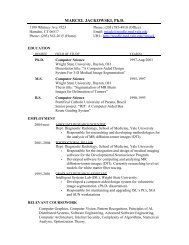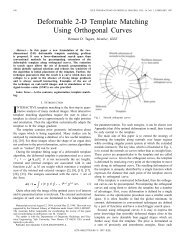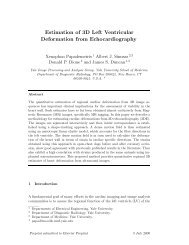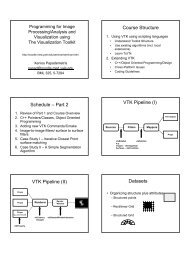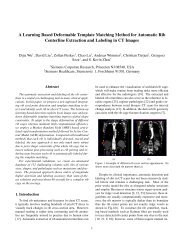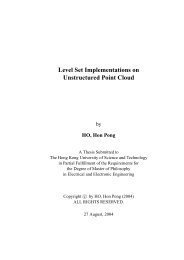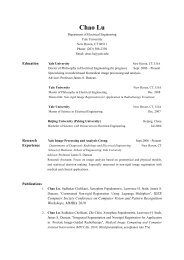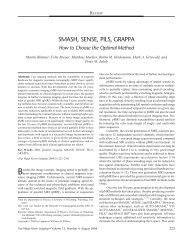Pulsed-field gradient nuclear magnetic resonance as a tool for ...
Pulsed-field gradient nuclear magnetic resonance as a tool for ...
Pulsed-field gradient nuclear magnetic resonance as a tool for ...
Create successful ePaper yourself
Turn your PDF publications into a flip-book with our unique Google optimized e-Paper software.
324<br />
PRICE<br />
Figure 7 A plot of simulated echo attenuation in the c<strong>as</strong>e of free diffusion Ž . and<br />
diffusion in a sphere Ž . b<strong>as</strong>ed on the GPD approximation Ži.e., Eq. 99. versus . The<br />
parameters used in the simulation were 1 ms, D 5 1010 m2s1 , g 1Tm1 ,<br />
R8m, and 1H 8 1 1 2.6571 10 rad T s . The echo attenuation in the c<strong>as</strong>e of<br />
diffusion in the sphere can be seen to go through three stages: Ž. i when 1, the diffusion<br />
appears unrestricted and the result is the same <strong>as</strong> that of free diffusion, Ž ii. <strong>as</strong> incre<strong>as</strong>es<br />
the spins begin to feel the effects of the surface, and Ž iii. when 1, the diffusion is fully<br />
restricted and the attenuation curve plateaus out.<br />
Ž 2 exp . term leaving the trigonometric Ž<br />
nm<br />
i.e.,<br />
periodic. function<br />
9Ž 2qR. cosŽ 2 qR. sinŽ 2 qR.<br />
EŽ q,. .<br />
6<br />
Ž 2qR.<br />
102 Obviously, <strong>as</strong> q incre<strong>as</strong>es, the denominator of Eq.<br />
102 incre<strong>as</strong>es Žsuch that Eq. 102 <strong>as</strong> a whole<br />
decre<strong>as</strong>es . , but the trigonometric functions in<br />
the numerator result in the function having an<br />
infinite series of maxima and minima. The minima<br />
occur when q takes a value such that<br />
Ž 2qR. cosŽ 2 qR. sinŽ 2 qR. 0, <strong>for</strong> the first<br />
minima, this occurs when q 0.71R. The simulated<br />
echo intensity calculated using both the<br />
GPD and SGP approximations versus qR is shown<br />
in Fig. 8. We can see that at small attenuation<br />
values, the GPD and SGP approximations agree<br />
very well Ž n.b., . , but at larger attenuation<br />
values, the SGP approximation gives diffractive<br />
minima, where<strong>as</strong> <strong>as</strong> expected, the GPD approximation<br />
does not. In well-chosen systems where<br />
the signal-to-noise ratio is sufficient and the sample<br />
geometry is monodisperse Žor<br />
at le<strong>as</strong>t not too<br />
2<br />
polydisperse . , it is possible to observe such minima<br />
e.g., Ž 105 ..<br />
The diffractive minima are an<br />
additional source of in<strong>for</strong>mation and their position<br />
is R dependent.<br />
Anisotropic Diffusion<br />
Earlier, it w<strong>as</strong> noted that isotropic diffusion is<br />
really just a special c<strong>as</strong>e, and more generally, we<br />
must consider anisotropic diffusion resulting from<br />
either the physical arrangement of the medium or<br />
anisotropic Ž i.e., nonspherical. restriction. Such<br />
situations commonly arise in biological Že.g.,<br />
cells,<br />
skeletal muscle. and liquid crystals systems e.g.,<br />
Refs. Ž 112, 113. and references therein ,<br />
thus the<br />
diffusion process is represented by a Cartesian<br />
tensor, D Ž see Free and Restricted Diffusion . . In<br />
such systems, the echo-signal attenuation will have<br />
an orientational dependence with respect<br />
to the me<strong>as</strong>uring <strong>gradient</strong>. For example, <strong>for</strong><br />
anisotropic free diffusion, the g 2 D term in Eq.<br />
<br />
51 must be replaced by g D g, where<br />
ÝÝ <br />
<br />
gDg D g g ,x, y, z 103



